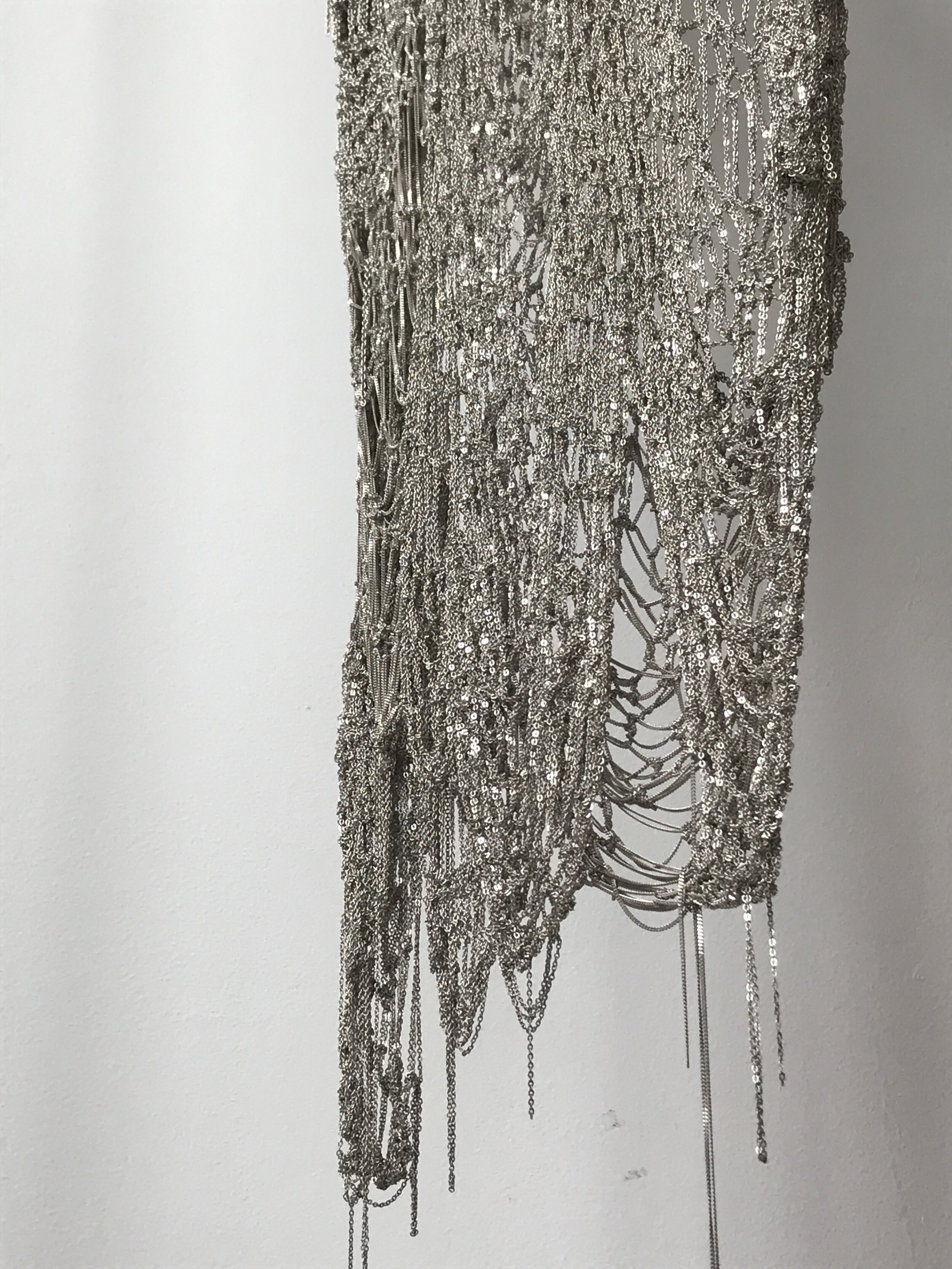
#BURNTGOLD : Glinting from Thunderdome
by Victoria Thomas
Sixteen years ago, Manhattan-based artisan and maker Arielle de Pinto invented her technique of crocheting metal chain without benefit of reference books or instruction. Today, she works without a pattern, creating garments, jewelry, masks and harnesses using free-form crochet, accented with hand-carved hardware. She creates an original textile narrative from materials including rose gold, vermeil, and Italian sterling silver.
Her “most coveted offering” is burnt gold, a hand-applied patina on top of vermeil. “We have a system and a way of making this color,” she says, “but after 14 years, it’s still unpredictable. The hues can be reddish, brown, purple, dark blue, light gold, umber, pink? Every chain we make is a bit different. It depends on so many factors, and one piece of chain can have an entire spectrum. We embrace it despite the challenges of offering something like this, in a market where the standard is zero variation.”
Arielle’s creations range from crocheted uppers for platform shoes to the popular “mini nuggy bracelet” which incorporates freshwater pearls. Her work appeals to a broad spectrum of perspectives, appearing in a Museum of Modern Art collaboration inspired by arms and armory, and featured in editorial bridal shoots where her intricate pieces are paired with virginal tulles and chiffons.
Speaking from her New York studio, she cites her Egyptian and Czech grandmothers as an intuitive source of inspiration: “Of course they knew how to crochet and knit,” she says. “Women in their time and place took their hand-traditions for granted, it was part of their language and everyday culture.”
In Arielle’s hands, metal takes on qualities that she calls “elemental and ancestral.” Her creations suggest medieval chain-mail, exumed royal finery, spider webs glinting in the shadows, frost-patterns forming on darkened windows, and shipwrecked lace wrenched from the bottom of the sea. Their shredded, dazzling asymmetry may even evoke a shimmering Tina Turner flashback, circa mid-1980s, glamorously post-apocalyptic.
Arielle’s creations are at once both hard and soft, seductive and war-like. Their mesh-texture feels cool when it first lands on the skin, then quickly warms to body-temperature, seeming to melt and mold to the form of the wearer.
The material itself is evocative and ambiguous. While we may think of metal as permanent and unyielding, she explains that with wear, her jewelry and garments are slowly transformed by their wearers. The shapes stretch subtly, and over time, the chain surfaces react to skin’s natural acidity with nuanced changes in color and finish. She comments, “It took me a long time to find suppliers that didn’t apply anti-tarnish coating.”
In 2020, feeling isolated from her loyal following because of the pandemic, Arielle created a “Wear and Tear” contest, inviting customers to post photographs of themselves wearing her work. Discreet signs of use are living proof that the pieces are worn hard and worn daily, and become as idiosyncratic as their owners.
A design signature: “drips”, free links which hang and swing from the central structure to give the piece sensual movement , suggest the weight and density of the substantial material itself, and perhaps even add a bit of belly-dancer’s jingle and Crusader’s clink.
She’s intrigued by the origins of needlework, believed to have originated in the Fertile Crescent. Unlike weaving, needlework does not require a loom, which made it easier for early people to create textiles. And the technique called nailbinding, which predated knitting and crocheting techniques, did not even require a spinning mechanism (short fibers were felted together, then looped with a flat, broad needle made of wood, antler, or bone). The portable nature of needlework of all kinds also made these arts ideal for trade in the ancient world.
The earliest-known example of nailbinding, a fragment of a mesh sieve made of plant fiber, was found in Israel’s Nehal Hamar cave, and dates from 6500 B.C.E.
In addition to their practical uses, knitting, knotting and crocheting often had talismanic powers in the ancient world. Many magical practices of antiquity involved wrapping and tying objects with cords, giving rise to the term “spell-binding.” Today, a bride and groom may have their hands (gently) tied together with a symbolic white ribbon to symbolize their union, a persistent memory of pagan binding traditions, a “lover’s knot.” The deep cultural resonance of all of these origins inhabits Arielle de Pinto’s art, making each piece feel like a half-erased memory, or fever-dream heirloom.
Arielle explains that, unlike knitting which can be produced flawlessly by machines today, crochet may be mimicked, but never replicated mechanically. “My technique is unique to human hands,” she says. “I honestly think that people respond to my work because it literally can’t be created any other way.”
All photos graciously supplied to Soolip courtesy of the artist, Arielle de Pinto.





